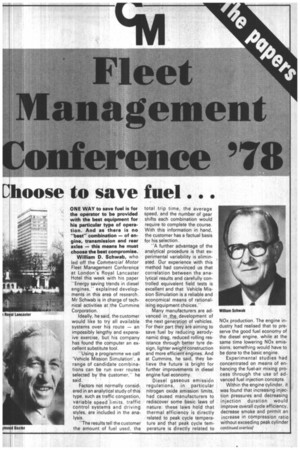hoose to save fuel . . .
Page 65

Page 66

If you've noticed an error in this article please click here to report it so we can fix it.
ONE WAY to save fuel is for the operator to be provided with the best equipment for his particular type of operation. And as there is no "best" combination — of engine, transmission and rear axles — this means he must choose the best compromise.
William D. Schwab, who led off the Commercial Motor Fleet Management Conference at London's Royal Lancaster Hotel this week with his paper "Energy saving trends in diesel engines," explained developments in this area of research. Mr Schwab is in charge of technical activities at the Cummins Corporation.
Ideally, he said, the customer would like to try all available systems over his route — an impossibly lengthy and expensive exercise, but his company has found the computer an excellent substitute tool.
"Using a programme we call 'Vehicle Mission Simulation', a range of candidate combinations can be run over routes selected by the customer,he said,
Factors not normally considered in an analytical study of this type, such as traffic congestion, variable speed limits, traffic control systems and driving styles, are included in the analysis.
"The results tell the customer the amount of fuel used, the
total trip time, the average speed, and the number of gear shifts each combination would require to complete the course. With this information in hand, the customer has a factual basis for his selection.
-A further advantage of the analytical procedure is that experimental variability is eliminated. Our experience with this method had convinced us that correlation between the analytical results and carefully controlled equivalent field tests is excellent and that Vehicle Mission Simulation is a reliable and economical means of rationalising equipment choices.
Many manufacturers are advanced in the development of the next generation of vehicles. For their part they are aiming to save fuel by reducing aerodynamic drag, reduced rolling resistance through better tyre design, lighter weight construction and more efficient engines. And at Cummins, he said, they believe the future is bright for further improvements in diesel engine fuel economy.
Diesel gaseous emissidn regulations, in particular nitrogen oxide emission limits, had caused manufacturers to rediscover some basic laws of nature: these laws hold that thermal efficiency is directly related to peak cycle temperature and that peak cycle temperature is directly related to NOx production. The engine industry had realised that to preserve the good fuel economy of the diesel engine, while at the same time lowering NOx emissions, something would have to be done to the basic engine.
Experimental studies had concentrated on means of enhancing the fuel-air mixing process through the use of advanced fuel injection concepts.
Within the engine cylinder, it was found that increasing injection pressures and decreasing injection duration would improve overall cycle efficiency, decrease smoke and permit an increase in compression ratio without exceeding peak cylinder continued overleaf
pressure limits. While, as expected, the unit injector, generating its injection pressure immediately at the injection nozzle, proved to have significant advantages over the pump-pipe-nozzle system in securing the thermodynamic advantages, proposers of these fuel injection systems are also moving to increase pressures and decrease injection periods.
They also found that much could be done to improve the overall efficiency of operation by reducing engine friction.
If the engine can operate at a somewhat lower speed and higher brake mean effective pressure, power can be pre
served while mechanical efficiency and overall fuel economy can be significantly improved. This rather simple principle, he said, is the basis for th "Formula Concept" which is now well known throughout the transport world (to acquaint drivers with this more efficient way of using their equipment, he illustrated his talk with the figure shown on this page).
Mr Schwab then turned his attention to the turbocharger — a further powerful means for improving the overall performance potential of the diesel engine and a key ingredient for the Formula Concept.
"The natural silencing effect of the turbine in the exhaust system plus the lower ignition delay resulting from elevated charge air temperatures produces a substantial overall noise reduction when compared to the same engine in naturallyaspirated form.
"The turbocharger also reduces smoke levels because it permits the engine to operate at higher air/fuel ratios. However, as is so often the case, benefits do not come without a price.
"In the case of the turbocharger, the price is stated in terms of transient response. The development engineer must trade off transient response, which the operator senses as driveability, against accelerati, smoke.. Severly limit acceleration smoke genera means sluggish driveabili while smart throttle respor generally results in hea exhaust smoke puffs."
The concept of driveabilit) difficult to define and quanti he said. But the use of rnotori dynamometers, capable simulating vehicle inertia, cot led to simulate driving styli had made it possible to inv tigate the detailed mechanii governing throttle response a acceleration smoke productio New technologies mean th vastly improved engines a engine components can now brought to the market pla much more quickly, he said.
Taking a glimpse into the ture, Mr Schwab said that wh turbocharged lorry engines w insulated components have r been subjected to extensive fif tests, dynamometer tests ha been made of turbocompou engines similar to those whi would receive the insulat treatment. These had shoN that dynamic response char; teristics of these engines can superior to those of convent nal turbocharged er1gines wldelivering greater power, lov emissions and lower noise.




























































































































